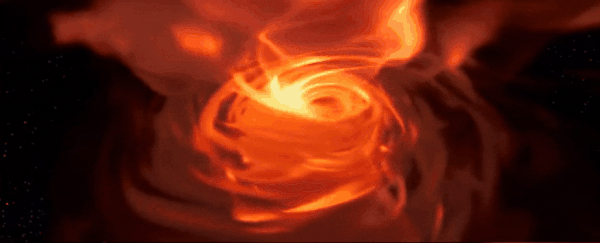At the heart of our galaxy, the core around which everything in the Milky Way orbits, lies the supermassive black hole Sagittarius A*. Without the gravitationally binding force of Sgr A*, the Milky Way wouldn't exist - yet, although it's only 25,640 light-years away, we've never seen it.
We'll never actually see a black hole, since they absorb all light. But over recent decades, astronomers and astrophysicists have been studying the space around Sgr A* intensely - and now a team of scientists has used that wealth of data to create a 3D, virtual-reality simulation of that space.
The result is a video astrophysicist Jordy Davelaar of Radboud University in the Netherlands - the first author of a paper on the new research - calls "one of the most realistic views of the direct surroundings of the black hole" yet produced.
And he is likely right.
"The increasing power of supercomputers and 3D codes now allows the scientists to include more and more physical effects," astrophysicist Jean-Pierre Luminet, research director of the French National Centre for Scientific Research (CNRS), who did not participate in the research, told ScienceAlert.
Here's what you're looking at. In the centre of the furiously roiling orange material is a black sphere.
That's the black hole itself - well, not a hole (sort of exactly the opposite of a hole, actually), and not actually really black, but the name is stuck now. It's an object that is so dense, and so gravitationally intense, that photons can't achieve escape velocity.
Around it is an example of one of the most extreme environments you'll find in the Universe. Swirling around the black hole is a whole lot of dust and gas.
Some of it will get caught up in the black hole's gravity, and fall down onto the object, where it's forever lost to us. Some will get caught up - we think - in the black hole's magnetic field lines, where it gets spewed out of the polar regions as relativistic jets.
"The light you see," Davelaar explains, "comes from matter that disappears into the black hole in a vortex-like way; due to the extreme conditions it becomes a plasma that starts to glow. This light is then deflected and deformed by the powerful gravity of the black hole."
Over the years, there have been several simulations of what the space around a black hole might look like. The most famous is probably Gargantua from the film Interstellar - but it's worth noting that scientific accuracy was sacrificed for cool visuals in that case.
The simulation created by Davelaar and his team doesn't look much like Gargantua. It looks more like earlier work produced by astrophysicists - the late Jean-Alain Marck of CNRS; and, of course, the work of Luminet, who produced the first image of a black hole's accretion disc in 1979.
 A still from Davelaar's simulation (left) and a 1989 simulation by Jean-Alain Marck (right). (Jean-Pierre Luminet)
A still from Davelaar's simulation (left) and a 1989 simulation by Jean-Alain Marck (right). (Jean-Pierre Luminet)
But there are still key differences - three of them, Luminet pointed out. The first is that the black hole in Davelaar's simulation is rotating with high angular momentum - Kerr spacetime (a rotating black hole) as opposed to Schwarzschild spacetime (a non-rotating black hole).
The second is that the accretion is not flowing from a flat disc, but a torus of matter. And the third is that Davelaar's simulation includes magnetic fields.
"It is essentially [the first and second points] that cause the differences in renditions," Luminet said. "The reason is that in Schwarzschild spacetime, all the orbits are planar [orbits on one plane], whereas in Kerr spacetime they are not, except for those confined in the equatorial plane."
It is more likely that Sgr A* is a Kerr black hole, so that difference between the simulations makes a lot of sense. But even so, they are not so different; toroidal accretion flows have been simulated before. The chief apparent difference is that Davelaar's simulation is moving.
But "it is precisely this dynamical rendition of a flight around a rotating BH that is for me the most exciting thing of this new simulation," Luminet noted.
So is something like this simulation what we're going to see when the Event Horizon Telescope collaboration releases the first ever photograph of Sgr A*'s event horizon horizon next year, a project years in the making?
Probably not, but not because the simulation is inaccurate, according to Luminet. It's because the viewing angle is directly on the black hole's equatorial plane - and it's extremely unlikely that Earth is directly on Sgr A*'s equatorial plane.
Either way, we're going to find out real soon, and either way, that's going to be freaking awesome.
The team's research has been published in the journal Computational Astrophysics and Cosmology.
